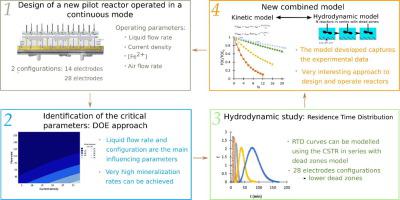Chemical Engineering Journal ( IF 15.1 ) Pub Date : 2020-09-19 , DOI: 10.1016/j.cej.2020.127048 Hélène Monteil , Yoan Pechaud , Nihal Oturan , Clément Trellu , Mehmet A. Oturan

|
The development of continuous flow electrochemical reactors is required to overcome the limitations of conventional batch reactors for treatment of large flows of effluents. Therefore, the objective of this study was to develop and characterize a new pilot-scale reactor using BDD anode and carbon felt cathode operating in continuous mode. First, a “Design of Experiment” analysis was performed in order to identify the most critical operating parameters for the percentage of mineralization of 29.8 mg L-1 hydrochlorothiazide (HCT) solution. The liquid flow rate has been identified as the most critical parameter together with the configuration of the reactor (number of electrodes, distance between electrodes). Moreover the designed reactor was able to reach very high percentage of mineralization (97%) for a mean residence time of 83 min. To better understand the important role of the flow rate and the configuration, a hydrodynamic study was then performed. “Residence Time Distribution” curves were obtained and fitted well with the continuous-stirred tank reactor in series with dead zones (CSTR-DZ) model. The 28-electrodes configuration had a lower dead volume fraction whatever the liquid flow rate applied. By increasing the liquid flow rate the hydrodynamic behavior tends more to a plug flow reactor. Finally, a new mathematical model for the mineralization of HCT solution was proposed by combining mineralization kinetic with hydrodynamic CSTR-DZ model. This model was then compared to experimental data and the model was able to capture experimental trends. This approach opens up interesting perspectives for a successful scale-up for continuous electrochemical reactors.
中文翻译:

用于通过电化学高级氧化工艺进行水处理的中试连续反应器:新型水动力/反应性联合模型的开发
需要开发连续流电化学反应器以克服常规间歇式反应器用于处理大流量废水的限制。因此,本研究的目的是开发和表征使用连续运行的BDD阳极和碳毡阴极的新型中试规模反应器。首先,进行“实验设计”分析,以便确定矿化百分比为29.8 mg L -1的最关键的运行参数氢氯噻嗪(HCT)溶液。液体流速与反应器的配置(电极数,电极间距离)一起被认为是最关键的参数。此外,设计的反应器能够在83分钟的平均停留时间内达到很高的矿化百分比(97%)。为了更好地理解流速和配置的重要作用,然后进行了流体动力学研究。获得了“停留时间分布”曲线,并与带有死区的连续搅拌釜反应器(CSTR-DZ)模型拟合得很好。无论施加何种液体流速,28电极配置的死体积分数都较低。通过增加液体流速,流体动力学行为更倾向于活塞流反应器。最后,通过将矿化动力学与流体动力学CSTR-DZ模型相结合,提出了一种新的HCT溶液矿化数学模型。然后将该模型与实验数据进行比较,并且该模型能够捕获实验趋势。这种方法为成功扩大连续电化学反应器开辟了有趣的前景。


























 京公网安备 11010802027423号
京公网安备 11010802027423号